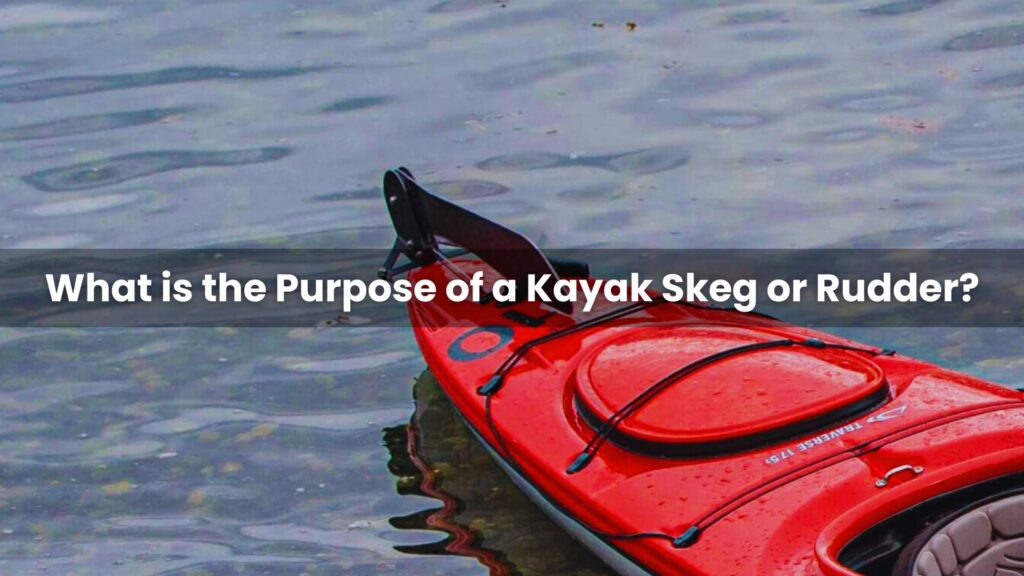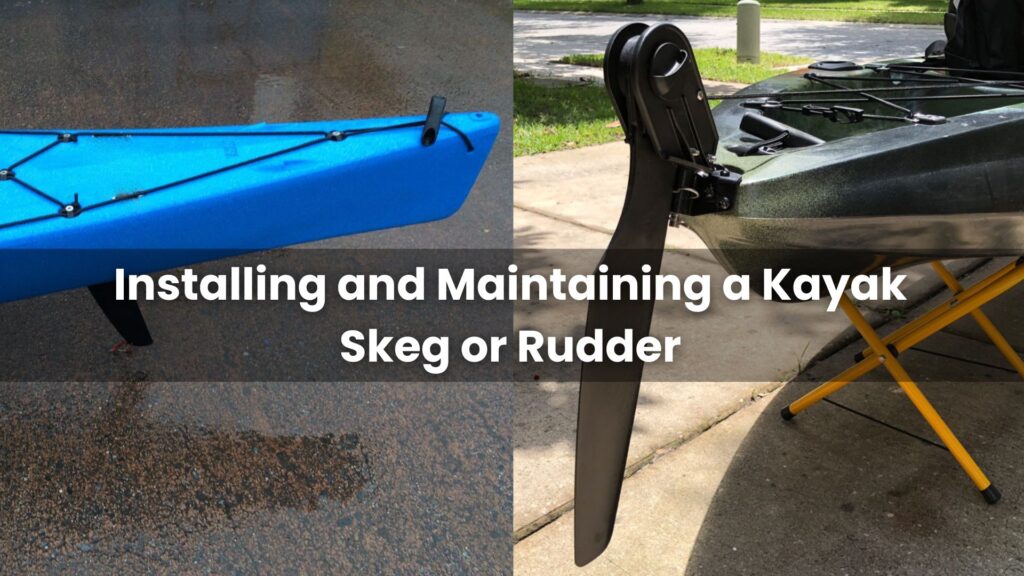Kayaking is a beloved water sport that offers a unique blend of adventure, tranquility, and connection with nature. As kayakers navigate through various waterways, the choice between a kayak skeg and a rudder becomes a crucial consideration. These two essential components play a vital role in the performance and handling of a kayak, and understanding the differences between them can greatly enhance the kayaking experience.
In this comprehensive guide, we will delve into the world of kayak skegs and rudders, exploring their definitions, functions, advantages, and the key factors to consider when deciding which one is best suited for your kayaking needs.
What is a Kayak Skeg?

A kayak skeg is a retractable blade that drops out of a slot in the hull of a kayak and extends into the water. Its primary function is to assist in the tracking of the kayak, helping it to maintain a straight path through the water. Unlike a rudder, which is designed to pivot side to side to steer the kayak, a skeg is fixed and does not move.
This means that while it does not aid in steering, it provides stability against crosswinds and currents that might otherwise cause the kayak to veer off course. The skeg can be adjusted lowered or raised, depending on the conditions and the paddler’s needs. By understanding the role of a kayak skeg, paddlers can make informed decisions about when and how to use it to enhance their kayaking experience.
What is a Kayak Rudder?

A kayak rudder is a blade located at the stern of the kayak that can pivot from side to side. It is controlled by foot pedals in the cockpit, allowing the paddler to steer the kayak while maintaining a forward motion. The primary function of a rudder is to aid in steering on windy days or in strong currents.
When the paddler pushes on the right pedal, the rudder moves to the right, causing the kayak to turn right, and vice versa. It’s an essential tool for maintaining course in challenging conditions, enabling more precise control over the kayak’s direction. Rudders are particularly useful for longer kayaks, which are faster but less maneuverable. They can be retracted when not in use to prevent damage and drag.
What is the Purpose of a Kayak Skeg or Rudder?

When it comes to kayaking, control and maneuverability are key to an enjoyable experience. This is where skegs and rudders come into play, each serving a unique purpose in aiding navigation on the water.
A kayak skeg is a fixed blade located under the stern of the kayak. Its primary function is to assist with directional stability, particularly in windy conditions or strong currents. The skeg works by minimizing the side-to-side motion, known as ‘weathercocking,’ that can occur when the wind hits the kayak from the side. By deploying the skeg, you can keep your kayak on a straighter course, allowing for more efficient paddling and energy conservation.
On the other hand, a rudder is a movable blade that is attached to the stern of the kayak and can be controlled by foot pedals from the cockpit. The rudder’s purpose is to provide precise steering and directional control. It is especially useful when making quick turns or navigating through tight spaces. Unlike the skeg, which is used to maintain a straight path, the rudder allows for active course adjustments while on the move.
Both skegs and rudders have their advantages and are chosen based on the kayaker’s preference, the type of water they will be navigating, and the specific conditions they anticipate encountering. Understanding the purpose of each can greatly enhance your kayaking experience, ensuring that you have the right tools to face the challenges of open waters.
Key Differences Between Kayak Skeg and Rudder

These two systems play a crucial role in enhancing a kayak’s performance, especially when it comes to tracking and maneuverability. Here’s what you need to know:
Purpose and Functionality
Skeg: A skeg is like a fixed fin that extends downward from the hull of the kayak. Its primary purpose is to improve tracking keeping the kayak moving in a straight line especially in challenging conditions like wind or waves. Unlike a rudder, a skeg cannot be turned; it only moves up or down.
Rudder: A rudder, on the other hand, is a movable blade attached to the stern (rear) of the kayak. It serves both tracking and directional control. You can adjust the rudder side to side, which allows you to steer the kayak more effectively.
Tracking and Stability
Skeg: Skegs excel at maintaining a straight course. They counteract the tendency of kayaks to weathercock (turn into the wind) or broach (turn sideways to following waves). In ideal conditions, a well-designed kayak should track well without a skeg.
Rudder: Rudders also aid in tracking but offer greater flexibility. They help keep the kayak on course while allowing you to make directional adjustments. If your kayak tends to turn easily or drift off course, a rudder can be a valuable addition.
Maneuverability
Skeg: While skegs enhance tracking, they don’t provide the same level of maneuverability as rudders. You won’t be able to turn a skeg to steer the kayak.
Rudder: Rudders allow you to fine-tune your direction. By adjusting the rudder, you can navigate around obstacles, make precise turns, and handle varying water conditions.
Conditions and Personal Preference
Skeg: Skegs are popular among sea kayakers and those who prioritize stability and simplicity. They work well in most conditions but shine when you need to maintain a straight line.
Rudder: Rudders suit paddlers who want versatility. If you’re dealing with strong crosswinds, complex currents, or need to make quick turns, a rudder provides that extra control.
Choosing Between Skeg and Rudder
Ultimately, the decision depends on your kayaking style, the type of water you’ll encounter, and personal preference. Some paddlers prefer the straightforward reliability of a skeg, while others appreciate the agility of a rudder.
Consider factors like wind patterns, the kayak’s design, and your own comfort level. Test both systems if possible to see which one feels more natural to you.
Advantages and Disadvantages of Using a Skeg on a Kayak
A skeg, a retractable blade that drops out of the hull of a kayak, is a pivotal feature for enhancing straight-line tracking in windy conditions or strong currents. Its primary function is to prevent the kayak from veering off course, allowing for a more efficient and enjoyable paddling experience.
Advantages of Using a Skeg
1. Improved Tracking:
A skeg helps to keep the kayak on a straight path, especially in side winds or when waves are hitting from the side.
2. Versatility:
Since a skeg can be adjusted, it offers varying levels of control based on the conditions. It can be fully retracted in calm waters or extended in challenging conditions.
3. Reduced Fatigue:
By maintaining a straighter course, paddlers can reduce the amount of corrective strokes needed, which in turn reduces fatigue.
4. Simplicity:
Skegs have fewer moving parts than rudders, making them less prone to damage and easier to maintain.
Disadvantages of Using a Skeg
1. Limited Maneuverability:
A skeg does not aid in turning the kayak, which can be a disadvantage in tight quarters or when quick directional changes are necessary.
2. Potential for Jamming:
Skegs can become jammed with debris or sand, which can be problematic when launching from or landing on beaches.
3. Learning Curve:
It may take time for paddlers to learn how to effectively use a skeg, especially when it comes to determining the optimal deployment level for different conditions.
4. No Assistance in Steering:
Unlike a rudder, a skeg does not help with steering the kayak, which means paddlers must rely solely on paddle strokes for directional control.
Advantages and Disadvantages of Using a Rudder on a Kayak
Navigating the waters in a kayak can be a serene and invigorating experience. To enhance this experience, kayakers often debate the merits of using a rudder versus a skeg. Understanding the advantages and disadvantages of a rudder can help you make an informed decision for your kayaking adventures.
Advantages of a Rudder
1. Improved Maneuverability: A rudder, controlled by foot pedals, allows for precise steering, which is particularly beneficial when paddling in windy conditions or strong currents.
2. Ease of Use for Beginners: New kayakers may find a rudder helpful as it can make the kayak more stable and easier to control.
3. Efficient Course Correction: With a rudder, small adjustments can be made without significant changes in paddling technique, allowing for a more straightforward course correction.
Disadvantages of a Rudder
1. Complexity and Maintenance: Rudders have moving parts that can be prone to damage and require regular maintenance.
2. Potential Overreliance: Some kayakers may become too reliant on the rudder for steering, which can impede the development of essential paddling skills.
3. Increased Drag: When not in use, a rudder can create additional drag, which can slow down the kayak and make paddling more strenuous.
When to Use a Skeg vs. a Rudder
When embarking on a kayaking adventure, understanding the conditions in which to use a skeg or a rudder can greatly enhance your experience. A skeg, which is a fixed blade located under the kayak, is ideal for maintaining a straight path in windy conditions or strong currents. It helps in tracking, which is the kayak’s ability to stay on a straight course, without affecting the kayak’s maneuverability. On the other hand, a rudder, operated by foot pedals, allows for more precise steering adjustments.
It is particularly useful when you need to make quick directional changes or when paddling in choppy waters. Both skeg and rudder serve to combat the effects of weathercocking, where the kayak tends to turn into the wind. However, the choice between a skeg and a rudder ultimately depends on the kayaker’s preference, the type of kayak, and the conditions they will be paddling in. While a skeg is more about passive tracking assistance, a rudder offers active steering control, making it a choice between a more hands-off or hands-on approach to navigation.
Installing and Maintaining a Kayak Skeg or Rudder

When it comes to enhancing the tracking ability of a kayak, both skegs and rudders serve as valuable tools for paddlers. However, their installation and maintenance differ significantly, reflecting their distinct functionalities.
Installing a Kayak Skeg
A kayak skeg, typically used in straight-line paddling across windy conditions, is a fixed blade located under the stern of the kayak. Installation involves mounting the skeg box within the kayak’s hull. The process requires precision to ensure the skeg deploys and retracts smoothly. It’s crucial to seal the skeg box properly to prevent water ingress.
Maintaining a Kayak Skeg
Maintenance of a skeg involves regular inspection for damage, ensuring the skeg cable operates freely, and occasionally lubricating the moving parts. It’s also important to clean any debris from the skeg box to prevent jamming.
Installing a Kayak Rudder
A rudder, on the other hand, provides directional control and is especially useful for maneuvering. Installing a rudder system is more complex, as it includes mounting the rudder at the stern, running cables or lines to the cockpit, and setting up the foot pedals that control the rudder’s movement.
Maintaining a Kayak Rudder
Rudder maintenance demands checking the integrity of all components, including the pedals, cables, and the rudder blade itself. Regular adjustments may be necessary to ensure responsive steering, and like the skeg, the rudder assembly should be kept clean and free of debris.
Both systems require a commitment to regular check-ups and a basic understanding of kayak mechanics. Proper installation and diligent maintenance will ensure that whether you choose a skeg or a rudder, your kayak will handle optimally in various paddling conditions. The choice between a skeg and a rudder ultimately depends on the type of paddling you plan to do and the conditions you expect to encounter.
Conclusion
In conclusion, both kayak skegs and rudders can be incredibly beneficial in their own right. Each accessory has its unique strengths, which can dramatically improve your control over your kayak’s handling in different water conditions. By understanding the purpose and benefits of each, you can make an informed decision about which one best fits your kayaking needs and preferences.
FAQs About Kayak Skeg vs Rudder
When it comes to choosing between a kayak skeg and a rudder, there are several questions that often arise. Here are seven frequently asked questions that can help you better understand the differences between these two systems:
What is the primary function of a kayak skeg and rudder?
A kayak skeg is used to improve the straight-line tracking of the vessel in windy conditions or strong currents, minimizing the need for corrective strokes. A rudder, on the other hand, is designed to steer the kayak, allowing for more precise control of the boat’s direction.
How does a skeg work compared to a rudder?
A skeg is a fixed blade that drops down from the bottom of the kayak’s stern and can be adjusted up and down. It doesn’t move side to side. A rudder is a movable blade controlled by foot pedals, which allows the paddler to make turns and directional changes.
When should I use a skeg?
Use a skeg when you need to maintain a straight path in windy conditions or when paddling in waves. It’s especially useful for long-distance touring where efficiency is key.
When is a rudder more beneficial?
A rudder is beneficial when you need more maneuverability, such as when navigating through tight spaces, making sharp turns, or when dealing with crosswinds that push the kayak off course.
Can I install both a skeg and a rudder on my kayak?
While it’s technically possible to have both, it’s not common practice because each serves a similar purpose. Kayakers typically choose one based on their specific needs and the type of kayaking they plan to do.
Does the choice between skeg and rudder affect the kayak’s performance?
Yes, the choice can affect performance. A skeg can improve the hydrodynamics of the kayak, making it faster in a straight line, while a rudder can slow the kayak slightly due to increased drag but offers better control.
What should I consider when deciding between a skeg and a rudder?
Consider your skill level, the type of kayaking you’ll be doing, and the conditions you’ll face. Beginners may appreciate the added control of a rudder, while more experienced kayakers might prefer the simplicity and efficiency of a skeg in certain conditions.

Nigel Foster, born in 1952, is an esteemed sea kayaker, known for being the youngest to kayak around Iceland. His journey in kayaking started at 15 in Brighton, England. With a career beginning as a trainee instructor in Sussex, he later pursued teaching after attending Redland College, Bristol.
Foster’s notable expeditions include navigating the challenging waters of Newfoundland and the Hudson Strait. Despite facing intense conditions, his passion for kayaking never waned. He holds several British Canoe Union qualifications and has significantly contributed to the kayaking community through teaching and committee work.
In 1985, Foster expanded his horizons by assisting an expedition in Iceland and later founded his own kayaking business, sharing his expertise globally.
